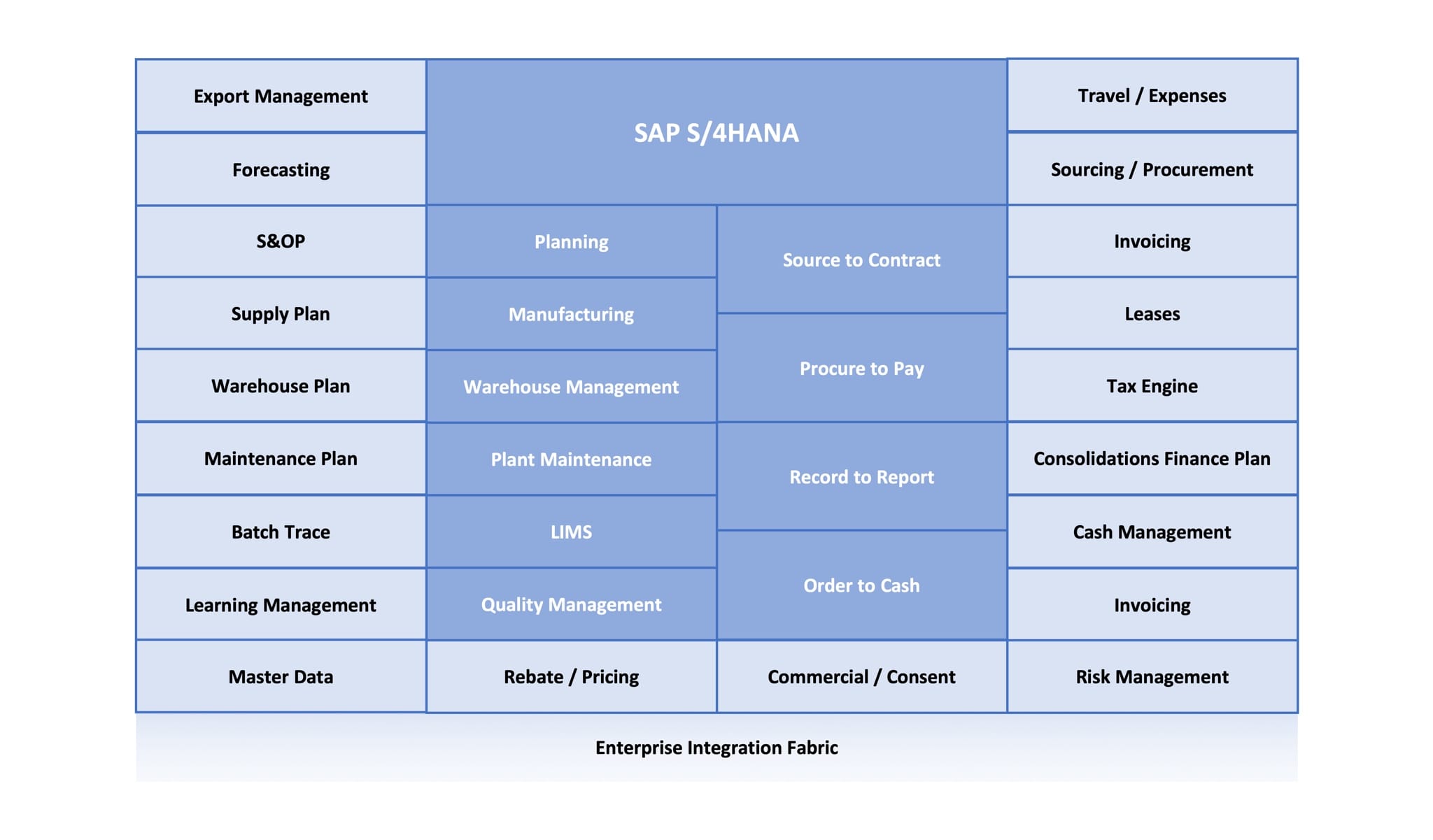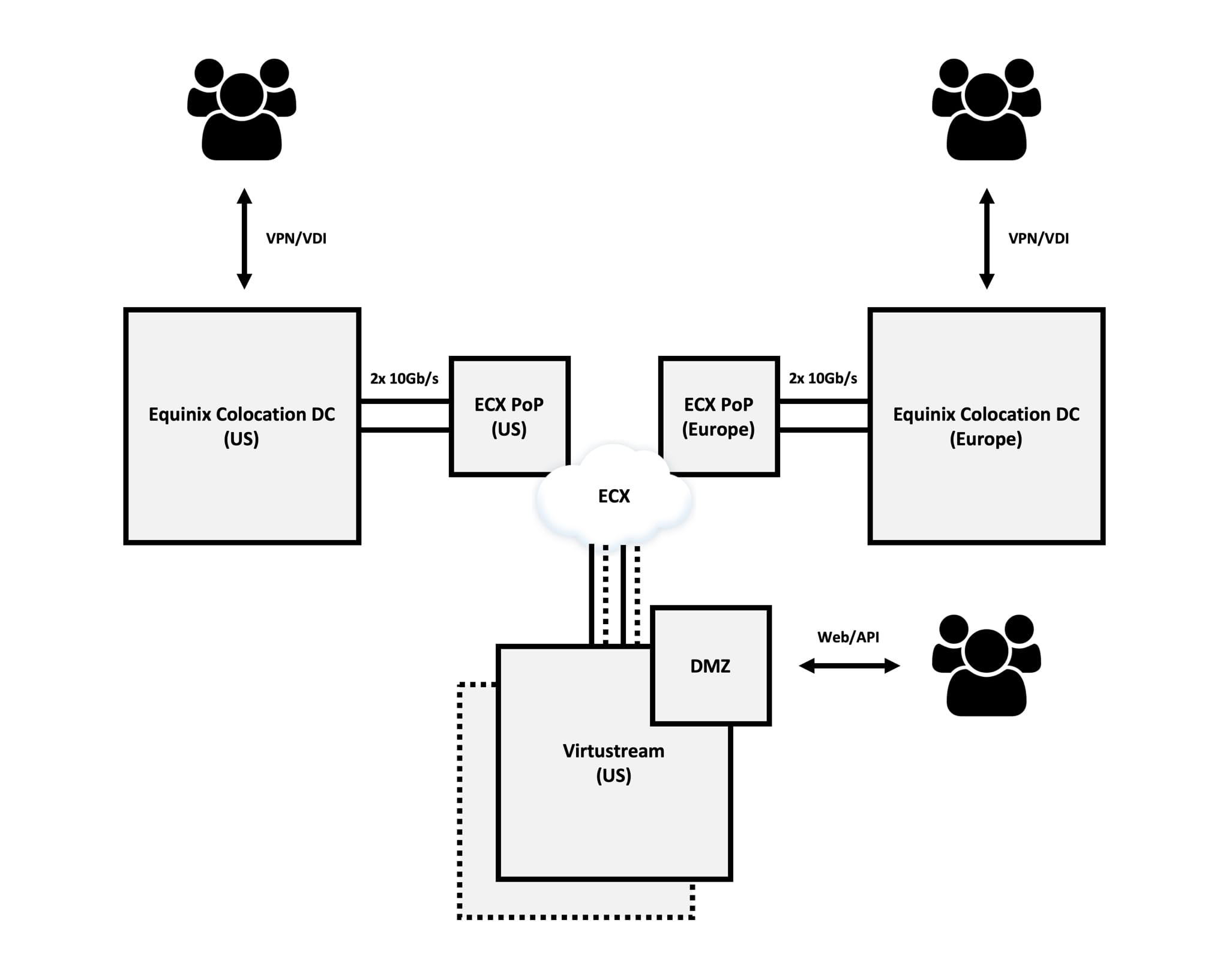Line of Business Apps
This article is part of a series. I would recommend reading the articles in order, starting with “Modern IT Ecosystem”, which provides the required framing.
- Modern IT Ecosystem
- Service Delivery
- SD-WAN
- Hybrid Multi-Cloud
- Automation
- Device-as-a-Service
- Identity Access Management
- Unified Communications
As a brief reminder, this series aims to explore the “art of the possible” if an enterprise business could hypothetically rebuild IT from the ground up, creating a modern IT ecosystem.
Within this article, I will highlight my proposed positioning for key Line of Business Applications, specifically Enterprise Resource Planning (ERP), Human Capital/Resourcing, Customer Relationship Management (CRM), Regulated Content and Data Management and Service Integration and Management (SIAM).
Introduction
The terminology “Line of Business Application” is not consistently defined, in the context of this article, I will use the term to describe a “mission-critical” application that supports a key business capability.
The typical business value chain includes many highly industrialised processes, covering Research & Development, Manufacturing, Commercial and Global Services. For example, Enterprise Resource Planning (ERP), Human Capital Management (HCM), Customer Relationship Management (CRM), etc. These are critical processes to any business, but could also be considered a commodity.
With this in mind, my philosophy would be to prioritise highly scalable, efficient and reliable services, instead of looking to differentiate where there is minimal competitive advantage.
Enterprise Resource Planning (ERP)
With the previously defined business characteristics in mind, I would position SAP S/4HANA as my Enterprise Resource Planning (ERP) solution, used to manage and track core business processes, resources (cash, materials, production capacity) and operations. The diagram below outlines which capabilities would be supported by SAP, highlighting core components (dark blue) and bolt-ons (light blue).

SAP can be an incredibly complex beast, therefore my preference would be to embrace the capabilities found in S/4HANA, avoiding (where possible) custom configuration.
My single instance of SAP would be hosted by Virtustream, who have a wealth of experience deploying and supporting SAP for large enterprise customers within their specialist (purpose-built) cloud.
I did explore the use of a Public Cloud provider (e.g. Azure) for SAP hosting but prioritised Virtustream based on the following value positioning.
-
Hosting/Basis: Virtustream deliver unified (one-vendor) SAP Hosting and Basis.
-
Full Stack: Virtustream would be accountable for the full technology stack and therefore not reliant on a third-party Public Cloud (e.g. Azure).
-
Experience/Expertise: Outside of SAP, Virtustream has the most experience deploying/supporting SAP.
-
Cost Effective: Virtustream leverage a unique consumption-based commercial model, delivered via fine-grained measurement of compute, memory, network and storage resources.
-
Hybrid Multi-Cloud: Virtustream is Public Cloud agnostic (reducing lock-in and protecting against data transit costs).
-
Architecture Alignment: Virtustream partner with Equinix, who I have positioned as my Colocation Data Centre provider.
-
Performance: Virtustream would peer with the Equinix ECX Fabric, enabling a cost-effective fibre cross-connect.
-
Dell Partnership: Virtustream are part of Dell Technologies, maximising my previously described investments across Dell Server, Dell Client, VMware and RSA.
With Virtustream, the business would get a fully-managed SAP instance (SaaS-like) and the benefits of a cloud (utility compute) cost model, combined with cost-effective “LAN-like” performance, that would not penalise for data transit.
The diagram below provides a high-level overview of my proposed Virtustream SAP Hosting architecture.

As depicted, the proposed architecture includes multiple user interaction points, including traditional VPN/VDI via the Colocation Data Centre infrastructure, as well as Direct Internet Access (DIA) for Cloud-Native (Web/API) interactions (embracing SAP Fiori).
Human Capital/Resourcing
I would position Workday as my unified platform for Human Capital/Resourcing, covering Human Capital Management (HCM), Human Resource Management (HRM) and Human Resource Planning (HRP).
-
Human Capital Management (HCM): A set of practices related to people resource management. These practices focus on the business need to provide specific competencies, covering workforce acquisition, workforce management and workforce optimisation.
-
Human Resource Management (HRM): The strategic approach to the effective management of people in a business, enabling a competitive advantage.
-
Human Resource Planning (HRP): The process of forecasting the future human resource requirements of the business and optimising the existing human resource capacity to meet specific business requirements.
Workday would support the following key business capabilities:
- Recruiting
- Onboarding
- Payroll
- Timekeeping
- Benefits
- Compensation
- Talent Management/Succession
- Organisation Management (Joiners, Movers, Leavers)
- Performance Management
- Reporting (HR, Headcount, Trending Workforce data, etc.)
Workday is a SaaS platform, with a strong focus on integrations (Workday API Documentation). Alongside SAP, it would become a primary source system of my proposed Identify Access Management (IAM) architecture.
Customer Relationship Management (CRM)
I would position Veeva CRM and Veeva Network for Customer Relationship Management (CRM) and Customer Master Data Management.
Veeva CRM is a vertical built on Salesforce.com, delivering specific capabilities for life sciences (the industry I selected as part of my previously defined business characteristics).
Over the years, Veeva CRM has become the “de facto” standard for Customer Relationship Management across life sciences, delivering advanced mobility, multichannel capabilities and real-time insights for sales teams. Looking outside of life sciences, if a clear market leader does not exist, I would explore Salesforce.com Sales Cloud and/or Microsoft Dynamics (depending on the business requirements and wider investments).
When combined with my proposed endpoint architecture, Veeva CRM would provide an easy to use, rich user experience that would aim to improve productivity for field teams that have limited “office/admin” time.
Veeva Network provides a highly integrated Customer Master Data Management capability, enabling localised business applications and a global data model. When enabled alongside Veeva CRM, it would deliver a seamless end-to-end experience, with no third-party integrations to manage.
Veeva Network also includes a wide range of standard integrations, for example, SAP Concur for expense reporting, which would help to streamline key business processes, whilst improving quality and transparency.
Veeva Network would form part of my wider Enterprise Data & Analytics architecture, which I plan to cover in a future article.
Finally, Veeva Approved Email and Veeva Cloud Loop Marketing (CLM) would be positioned to facilitate multi-channel engagement.
Regulated Content and Data Management
Building on my Veeva CRM and Veeva Network investments, I would position Veeva Vault as my enterprise content management platform. Veeva Vault would manage both content and data, enabling end-to-end processes across commercial, medical, clinical, regulatory, quality and safety. As per my previous defined business characteristics) these processes would be critical to help ensure regulatory compliance.
The Veeva Vault Platform includes multiple applications, specifically:

To maximise the return on investment, I would position the use of the following applications, supporting multiple business functions (R&D, Manufacturing, Commercial and Global Services).
-
Vault Clinical Operations: Supporting the study process and method control, providing a single system of record for shared CTMS, TMF and study start-up content.
-
Vault Quality Suite: Supporting the Quality/Control processes, covering Quality Plan, Action Tracking, Change, Deviation, Complaint, Audit, Lab Investigation, Product Safety Assessment (PSA) and Notification to Management (NTM). Veeva Quality Suite would also act as the authoritative source for quality documentation/content (e.g. Procedures, Policies, Validation, Reports, etc.)
-
Vault RIM Suite: Supporting the planning, execution and oversight of all regulatory activities within a single, unified Regulatory Information Management (RIM) application.
-
Vault Safety: Supporting the collection, management and real-time oversight of adverse events.
-
Vault PromoMats: Supporting commercial and scientific disclosure, providing digital asset management, review and distribution capabilities.
Similar to Veeva CRM and Veeva Network, Veeva Vault is a SaaS platform (adhering to my previously defined IT principles and IT declarations).
Service Integration and Management (SIAM)
Service Integration and Management (SIAM) is an approach to manage, integrate and unify multiple vendors, helping them to deliver end-to-end services that meet specific business requirements. SIAM replaces the traditional approach, where vendors are managed in isolation, with separate processes and expectations, often resulting in hand-off issues and/or “finger-pointing”.
Specifically, SIAM enforces a combined “revenue at risk” model, which contractually dictates the holistic performance (shared Service Level Agreements) across all vendors, incentivising collaboration and collective innovation.
To enable effective Service Integration and Management (SIAM), the following IT capabilities would need to be established and maintained.
-
Service Integration Governance: Define, establish and continuously adapt the service integration governance.
-
Service Integration Organisation: Develop and manage a distributed organisation supporting changing business requirements.
-
Business Requirements: Manage business demand and develop a service portfolio in alignment with business requirements.
-
Tools and Information: Manage distributed information and the integration tool solutions.
-
Providers and Contracts: Select an appropriate provider portfolio and to manage the providers according to the outsourcing contracts.
-
End-to-end Services: Understand and manage the business services end-to-end, covering business and IT services.
Recognising the critical importance of IT Service Management (ITSM) as part of Service Integration and Management (SIAM), I would position ServiceNow as my unified ITSM/SIAM platform. ServiceNow would support the following key capabilities:
- Configuration Management
- Problem Management
- Change Management
- Incident Management
- Knowledge Management
- Request Fulfilment Management
- IT Asset Reconciliation (Hardware and Software)
- IT Cost Management
- Business Process Tracking (IT Business Management)
- User Effort/Satisfaction (KA Surveys)
As outlined above, leveraging the integrations provided by Workday, ServiceNow would compliment specific HR processes, providing workflow capabilities for HR/Ethics and Compliance Case Management, as well as host the previously described Information Portal.
Conclusion
As outlined in the article “Modern IT Ecosystem”, my goal was to target SaaS providers for all highly-industrialised/commodity capabilities, regardless of business criticality.
I believe the capabilities and positioning outlined in this article demonstrate how this could be achieved (even within a regulated industry), enabling “best in class” services, with a focus on the business requirements (not the underlying technology).
Recognising the additional benefits of SaaS, specifically reduced implementation time, simplified support and continuous updates, I believe my “Cloud First” strategy would dramatically improve business agility, enabling a better outcome for the customer.